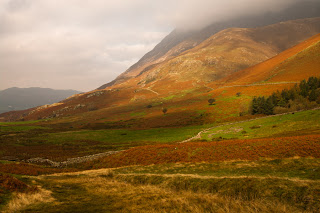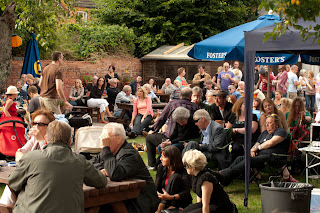A friend of mine, Stephen Wass, is doing a PhD course and is working as an archeologist for the National Trust (NT) at Farnborough Hall. Stephen asked me to help by taking some photographs of the survey work he's undertaking.
The Hall is an 18th century mansion and it sits in 115 hectares (284 acres) in Warwickshire in the midlands of England. A massive site with some extraordinary feats of engineering and architecture, it was passed to the ownership of the NT in 1960 and is still occupied by the Holbech family who built the house in the late 17th century. Prior to that it was in the hands of a minor branch of the Raleighs (of Sir Walter fame). Here's the Hall:
The site contains some really amazing features including several man made lakes, walks with classical architectural features and what is being called an "amphitheatre" - not a Roman one, but a rare Georgian parkland feature which is thought to have been used as a focal point of a walk in the parkland with friends. Apparently, the gentry would walk with friends for hours on end and it was necessary to provide places to walk. Sometimes, as might have been the case at Farnborough, this involved the removal of the odd village or two - with no obligation to rehouse the tennants. There is the site of a medieval village on the estate which would have spoiled the view so that might account for its disappearance - although there are other reasons for villages disappearing.
Many of the features are buried and overgrown. As I say, it's a massive site and there are any number of projects which could be undertaken; some of which will be emergency work to prevent another feature from disappearing for ever. I suspect that the family passed the Hall on to the NT in order to save the house and its contents which were collected during the Grand Tour. The parkland is a huge undertaking and some of its major features have been neglected for many, many years.
The photography was mainly archeological record shots so you'll see measuring scales and ranging poles in many of them - but I've got an open invitation to return whenever Stephen is there and do any other photography. Could be a lifetime's work. Here's a selection of pictures from the day and I've included a link to a gallery of all of the ones which will be of interest to Stephen.
A funeral bier for wheeling coffins into church. It's stored in a bier store (loads of opportunity for misunderstanding there!) just outside the churchyard of the Norman St Botolph's church.
The gardener's cottage in the walled garden. The garden is huge and would have provided all of the fruit and vegetables for the house. Sadly it's now derelict.
Tools in the workshop in the Hall yard
St Botolph's Well. A holy well at least as old as the Norman church (also dedicated to St Botolph) and possibly Saxon or even earlier.
An almost collapsed apple tree in the orchard. A survey has shown that there are trees here dating from possibly as early as the early 17th century - and maybe one that is a unique variety found nowhere else. Although this one is in a sorry state, it's still a prolific fruiter, but the apples are very sour so it may be a cider variety.
This shows the extent of some of the earthworks. Where Stephen is standing would have been water in the 18th century and where I am, taking the photograph, is the top of a man made dam. A huge engineering feat predating canals and railways by many years.
The "amphitheatre" is a difficult feature to photograph as it's covered with mature trees and bushes, none of which, with the exception of a single yew tree, would have been there in the 18th century. Here's a shot of the embankment at the rear of the feature - another example of the substantial civil engineering that was carried out on the site.
Stephen's pride and joy - the cascade. Still running using the 18th century water system of culverts and siphons to carry water to the various features in the park. Stephen has recorded the cascade stone by stone and I was able to photograph every section so he can finish the detailed drawings without having to be on site for hours on end. Sadly, parts of this structure are in danger of imminent collapse so the public is not allowed near it at present.
The terraced walk. This is open to the public on visiting days and is a great example of its type. It runs about 3/4 mile and has places to stop and admire the views of the park and beyond. It overlooks Edge Hill, the site of one of the bloodiest battles in the English Civil War. The walkway has bastions on which are features such as the Ionic Temple and it is thought to reflect the military features in the distant landscape.
Finally, looking back towards the church from the Game Larder - used for just what it says, hanging game until it became ripe enough for Gerogian tastes; i.e. nearly rotten. Just below the church is the site of the medieval village that may have been removed to improve the view!
That's it for now. Chris.



































